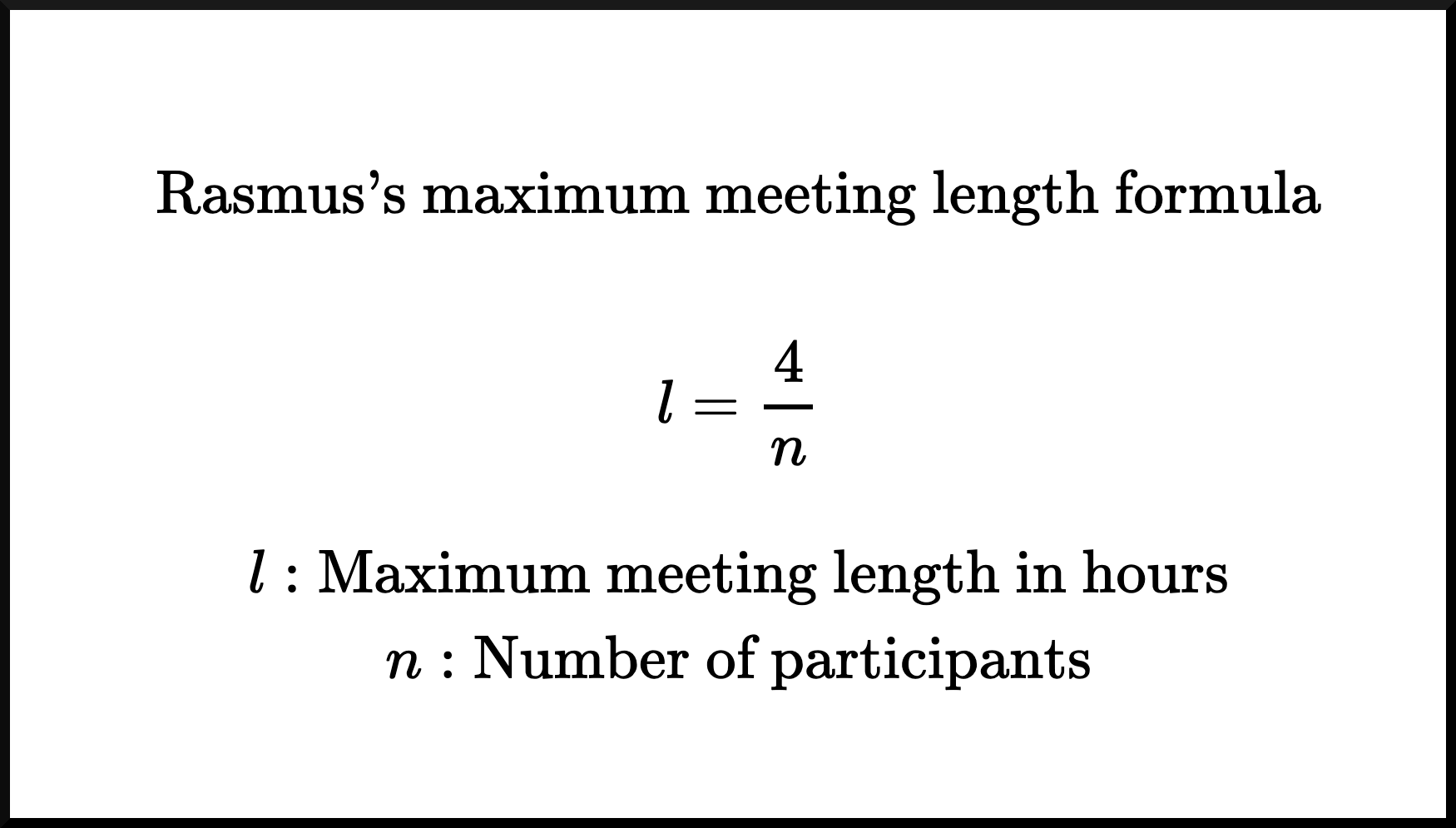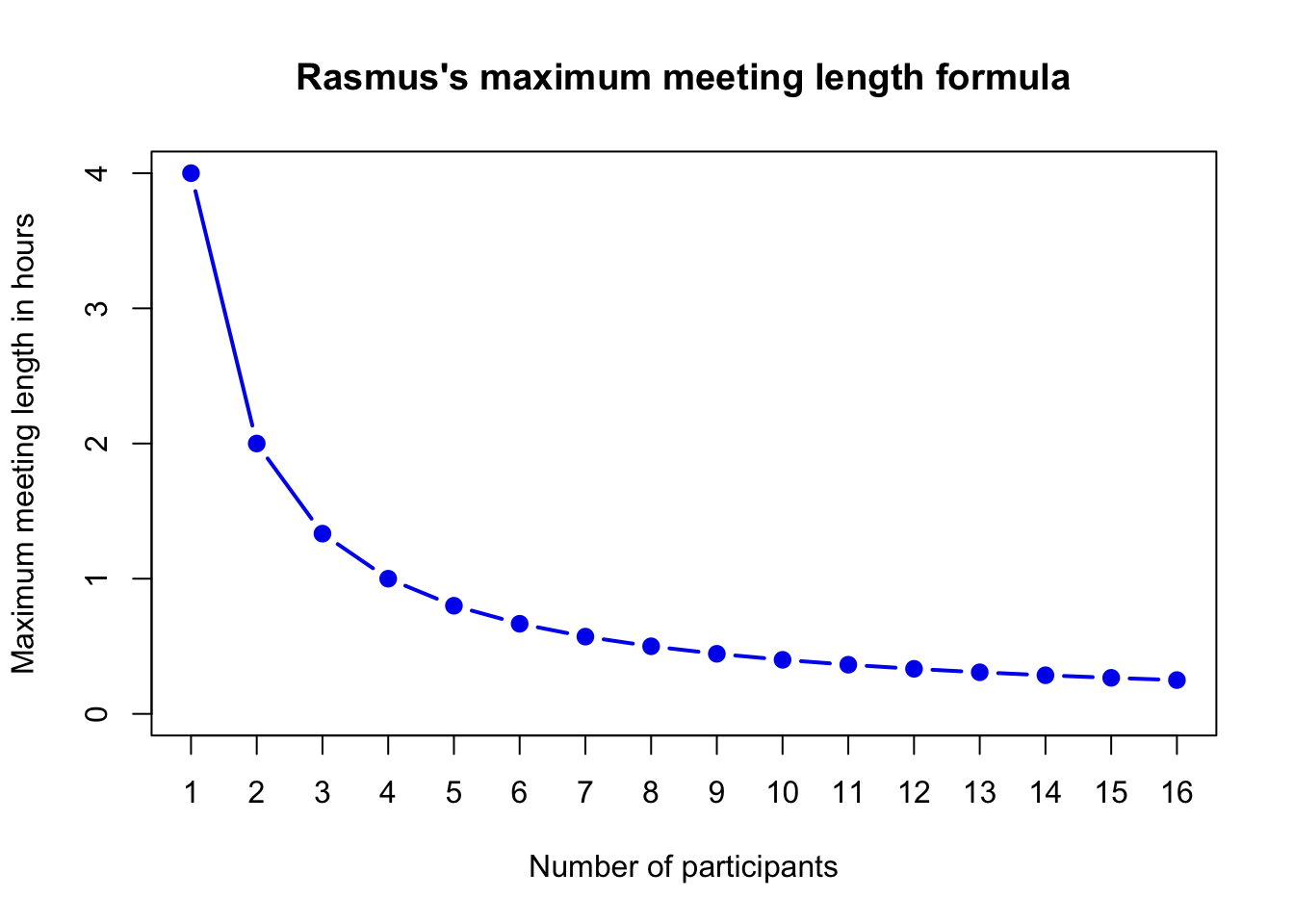I’ve now been in the industry long enough to know that meetings are often too long. No one likes to be in meetings, and the longer they are, the worse it is. Not only do I know most meetings are too long, but I also know exactly how long a meeting should be, at most! Let’s not delay it any further; here’s Rasmus’s maximum meeting length formula:

You can see that I’m confident about the correctness of this formula, as I’ve already branded it with my own name and rendered it in $\LaTeX$. If that’s not enough to convince you, let me break it down further:
- If you’re four meeting participants, then the maximum meeting length is 4 h / 4 = 1 h. As you’re four people, on average, you’ll have to listen to someone else talking 75% of the time. Having to be quiet for most of the time, it’s already going to be challenging for participants to keep the focus, but after 1h, it’s going to be impossible.
- If you’re eight people, the situation is worse! You’re almost never going to be the one talking, and there’s a risk that most of the time, no one’s going to talk about something that directly affects you. What was the meeting about, anyway? No one is going to endure more than 4 h / 8 = 30 min of that.
- At 16 people, the amount any given person will get to talk is so low, and the probability that you’re wasting most participants’ time is so high, that you should, at most, do a stand-up sized 4 h / 16 = 15 min meeting.
- If you’re only two persons meeting, then I think you can go on for quite some time, as either you’re the one talking, or someone is talking directly to you. But still, after 4 h / 2 = 2 h, both participants will surely be too exhausted to go on.
- If it’s only you in the meeting, then I guess you can spend quite some time with yourself. But after 4 h / 1 = 4 h, even you will start growing tired of yourself and need to take a break and meet other people.
So these considerations make up the rationale for Rasmus’s maximum meeting length formula which, again, is:

Some Q&A:
- Q: “But I’ve been in meetings with more than 16 participants that went on for hours. How does your formula account for that?!”
- A: First, I’m sorry. And secondly, was that really a meeting? Would you say that going to the theater is going to “a meeting”? A “meeting” with many in the audience looking at the few speaking, like a company all-hands, is not a meeting. It’s a performance. And as such, it is not covered by Rasmus’s maximum meeting length formula.
- Q: “So how should I use the formula?”
- A: If you’re booking a meeting for eight people and you’re unsure if a 1 h meeting is too long, then use the formula (4 h / 8 = 30 min) to learn that: Yes! It’s too long! If someone tries to book a 2h meeting with you and your 10 teammates, throw the formula at them to tell them that: Yes, it’s too long! Don’t hesitate to refer to this page, as well. Maybe link to it from the company wiki?
- Q: “So should a meeting with eight people always be 30 min long?”
- A: No, no, no!! It’s Rasmus’s maximum meeting length formula, but shorter is always better when it comes to meetings.
- Q: “But what if the eight of us can’t get through all the points in a 30 min meeting? Surely we can then book a longer…”
- A: No! A 30-minute meeting is the maximum length for eight people. But there are a couple of strategies here. Maybe not all eight people need to be in the meeting? If you select four representatives, you can have your 1-hour meeting! Or maybe you could actually do some prep work, like making a better-defined agenda and a short pre-read, to give everyone the context they need to keep the meeting short and focused. Or, worst case, you could… book a second meeting?
- Q: “But what about that cozy kind of meeting that includes coffee and cake?”
- A: Ah! You’re talking about the cake modifier c. I’m still researching that, but everything points to that meetings with cake can be allowed to be much longer. Depending on the quality of the cake, of course.
- Q: “I can’t read formulas, can you turn it into a graph instead?”
- A: Yes, certainly!

Posted by Rasmus Bååth | 2023-12-25 | Tags:
Work